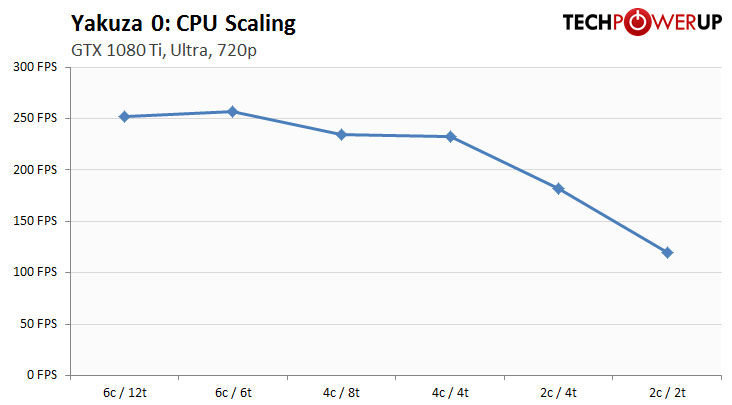 24
24
Yakuza 0 Benchmark Performance Analysis
Conclusion »Test System
| Test System | |
|---|---|
| Processor: | Intel Core i7-8700K @ 4.8 GHz (Coffee Lake, 8192 KB Cache) |
| Motherboard: | ASUS Maximus X Code Intel Z370 |
| Memory: | G.SKILL 16 GB Trident-Z DDR4 @ 3866 MHz 18-19-19-39 |
| Storage: | 2x Patriot Ignite 960 GB SSD |
| Power Supply: | Antec HCP-1200 1200 W |
| Cooler: | Cryorig R1 Universal 2x 140 mm fan |
| Software: | Windows 10 64-bit Creators Update |
| Drivers: | NVIDIA: 398.82 WHQL AMD: Catalyst 18.7.1 WHQL |
| Display: | Acer CB240HYKbmjdpr 24" 3840x2160 |
We used the latest public release version of the game (not a press pre-release). We also used the latest game-ready drivers from NVIDIA. AMD at this time has no plans to release a driver for Yakuza 0, so we used their latest 18.7.1 WHQL.
Graphics Memory Usage

Using a GTX 1080 Ti, which has 11 GB of VRAM, we tested the game's memory usage at Ultra settings with and without 2x Super Sampling.
As expected, with Yakuza 0 being an older title originally and without a significant improvement in texture or model quality, memory requirements are extremely modest. Even cards with smaller memory sizes, like 2 GB or 3 GB, will be fine, even at 4K with Super Sampling-
GPU Performance



GPU Performance with 2x Supersampling



CPU Scaling
We also tested the game with various core counts and HyperThreading on/off using a GTX 1080 Ti. The 720p results serve as an indicator of the CPU bottleneck—faster graphics hardware, no matter the resolution, can not give you more FPS than the results at 720p.



Mar 10th, 2025 16:24 EDT
change timezone
Latest GPU Drivers
New Forum Posts
- Fix for Vram always at maximum (0)
- Maxsun RX580 graphics card crashes (25)
- DLSS as antialiasing? (19)
- Please I need help with the poor performance that my PC is giving me (28)
- Company of Heroes 3 (5)
- The TPU Darkroom - Digital SLR and Photography Club (4071)
- A Final Fantasy IX Reminiscence - My love letter and homage to one of the best stories ever told (72)
- Gaming PC instabiliity (20)
- Msi 5090 DOA? (27)
- 3D Printer Club (447)
Popular Reviews
- Sapphire Radeon RX 9070 XT Nitro+ Review - Beating NVIDIA
- XFX Radeon RX 9070 XT Mercury OC Magnetic Air Review
- ASUS Radeon RX 9070 TUF OC Review
- MSI MAG B850 Tomahawk Max Wi-Fi Review
- NVIDIA GeForce RTX 5080 Founders Edition Review
- NVIDIA GeForce RTX 5070 Founders Edition Review
- Corsair Vengeance RGB CUDIMM DDR5-8800 48 GB CL42 Review
- AMD Ryzen 7 9800X3D Review - The Best Gaming Processor
- ASUS GeForce RTX 5070 Ti TUF OC Review
- MSI GeForce RTX 5070 Ti Gaming Trio OC+ Review
Controversial News Posts
- NVIDIA GeForce RTX 50 Cards Spotted with Missing ROPs, NVIDIA Confirms the Issue, Multiple Vendors Affected (513)
- AMD Plans Aggressive Price Competition with Radeon RX 9000 Series (277)
- AMD Radeon RX 9070 and 9070 XT Listed On Amazon - One Buyer Snags a Unit (261)
- AMD RDNA 4 and Radeon RX 9070 Series Unveiled: $549 & $599 (260)
- AMD Mentions Sub-$700 Pricing for Radeon RX 9070 GPU Series, Looks Like NV Minus $50 Again (248)
- NVIDIA Investigates GeForce RTX 50 Series "Blackwell" Black Screen and BSOD Issues (244)
- AMD Radeon RX 9070 and 9070 XT Official Performance Metrics Leaked, +42% 4K Performance Over Radeon RX 7900 GRE (195)
- AMD Radeon RX 9070-series Pricing Leaks Courtesy of MicroCenter (158)